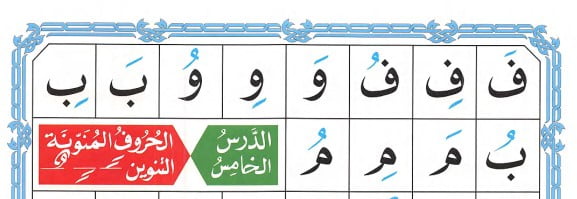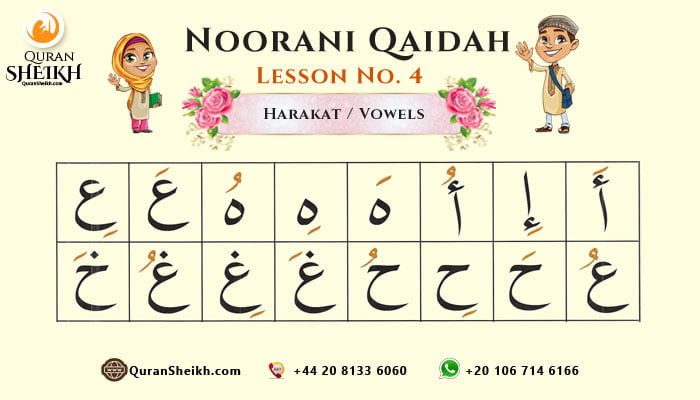Noorani Qaida Lesson 4: Master Harakat (ــَــِــُ) – Short Vowels for Quranic Fluency
Noorani Qaida lesson 4: Arabic comprises six vowels: three short vowels (Fathah, Kasrah, Dammah) and three long vowels (Alif, Waw, Yaa)..
This lesson covers the Arabic Short vowels. As just like in the English language there are vowels (a, e, i, o, u) to make different sounds. In the Arabic language, it also has some vowels, but they are only three.
Remembered that we have touched these letters in the first lesson Noorani Qaida lesson 1. In Arabic language, this lesson is named as حركه” ” for one vowel and حرکات”” for vowels.
In Tajweed, Ulamaa defines the word حركه with the “a finger movement”. For example, opening OR closing of a finger at a normal pace. It is a measurement of sound or duration of a sound.
Noorani Qaida Lesson 4 Video:
Learn Noorani Qaida Lesson 4 (Harakat) to master Arabic vowels (Fatha, Kasra, Damma) with clear Quranic examples. Perfect for beginners and kids! Build confidence in Quran reading step-by-step. Watch now and join thousands of students improving their Tajweed! 🌟
Join thousands of Muslim Families who love learning Noorani Qaida & Quran reading from the comfort of their Homes.
We have three حرکات (vowels) in Arabic language:
Arabic Short Vowels (Fathah فتحة)
Consider فتحة a line that goes on the top of any letter.
Example: بَ. Here you see the letter ب having a small line on it. This is called فتحة.
Arabic Short Vowels (Kasrah كسرة)
Consider it line that goes below or under any letter.
Example: بِ. here you see the letter ب having a small line below it. This is called كسرة.
Arabic Short Vowels (Dhammah ضمّة)
Example: بُ. here you see that a small و appears on the top of the letter ب. this is called ضمّة.
Consider it like a small و written above any letter.
Repeat above three vowels (Fathah, Kasrah and dhammah) until you master these words because these three words will be used throughout the series of lessons.
- Fathah فتحة makes a sound of AA (read it by opening your mouth).
- Kasrah كسرة makes a sound of EE.
- Dhammah ضمّة makes a sound of UU.
Note: These three sounds should be for a short duration of time as earlier it is said that Harakah is a movement.
Now we will put them in practice by starting our Noorani Qaida lesson 3. In this lesson, you will see that each letter is repeated three times with respect to the vowels we just have studied. If you have practiced the first lesson (where we studied the home of every letter) perfectly then this lesson will be very easy for you.

ءَ: it is read out as “hamza fathah A”.
Precaution: read it without pausing and don’t stretch the ending letters like ا ، و ، ی OR A,E,O appearing at the end of the word. Read out each group of letters combine also. Remember this precaution throughout the lesson.
ءِ: it is read out as “Hamzah kasrah E”.
ءُ: read out it as “Hamzah dhammah U.
ہَ: read it as “ھا فتحہ ها” (Haaa fathah Ha).
ہِ: read it as “ھا کسرہ هي ” (Haa kasrah he).
Remember: don’t stretch the letter ی here.
ہُ: read it as “ھا ضمّه ھو” (Haa dhammah Hu).
Remember: don’t stretch the و here. Fathah, kasrah, and dhammah are nothing but move the letters in different directions.
عَ: read it out as “ عین فتحہ عا” (ayeen fathah A).
Precaution: use the ع sound carefully otherwise it may become ء. so be careful while reading this letter.
عِ: read it as “ عین کسرہ عی” (ayeen kasrah E).
عُ: read it as “عین ضمّه عو” (ayeen dhammah U).
حَ: read it as “ حا فتحہ حا” (Haa fathah Ha).
Remember here the sound of ح not ھ.
حِ: read it as “ حا کسرہ حی ” (Haa kasrah He).
حُ: read it as “ حا ضمّه حو” (Haa dhammah hu).
غَ: read it as “ غین فتحہ غا” (ghayeen fathah gha).
Remember: this is a heavy letter so make a heavy a sound at the end of the letter.
غِ: read it as “ غین کسرہ غی” (ghayeen kasrah ghe).
غُ: read it as “ غین ضمّه غو” (ghayeen dhammah ghu).
خَ: read it as “خا فتحہ خا” (Khaa fathah kha).
خِ: read it as “ خا کسرہ خی” (khaa kasrah khe).
خُ: read it as “ خا ضمّه خو” (khaa dhammah khu).
قَ: read it as “ قاف فتحہ قا” (qaaf fathah qa).
قِ: read it as “ قاف کسرہ قی” (qaaf kasrah qe).
قُ: read it as “ قاف ضمّه قو” (qaaf dhammah qu).
کَ: read it as “کاف فتحہ کا” (Kaaf fathah ka).
کِ: read it as “ کاف کسرہ کی” (kaaf kasrah ke).
کُ: read it as “ کاف ضمّه کو”(kaaf dhammah ku).
جَ: read it as “ جیم فتحہ جا” (jeem fathah Ja).
جِ: read it as “ جیم فتحہ جی”(jeem kasrah je).
جُ: read it as “ جیم ضمّه جو” (jeem dhammah ju).
شَ: read it as “ شین فتحہ شا”(sheen fathah sha).
شِ: read it as “ شین کسرہ شی ” (sheen kasrah she).
شُ: read it as “ شین ضمّه شو”(sheen dhammah shu).
یَ: read it as “ یا فتحہ یا” (yaa fathah ya).
یِ: read it as “ یا کسرہ یی”(yaa kasrah ye).
یُ: read it as “ یا ضمّه یو”(yaa dhammah yu).
ضَ: read it as “ ضاد فتحہ ضا”(daad fathah da).
ضِ: read it as “ ضاد کسرہ ضی”(daad kasrah de).
ضُ: read it as “ ضاد ضمّه ضو” (daad dhammah du).
لَ: read it as “ لام فتحہ لا” (laam fathah la).
لِ: read it as “ لام کسرہ لی”(laam kasrah le).
لُ: read it as “ لام ضمّه لو”(laam dhammah lu).
نَ: read it as “ نون فتحہ نا”(noon fathah na).
نِ: read it as “ نون کسرہ نی”(noon kasrah ne).
نُ: read it as “ نون ضمّه نو”(noon dhammah nu).
رَ: read it as “ را فتحہ ر” (raa fathah ra).
رِ: read it as “را کسرہ ری”(raa kasrah re).
رُ: read it as “ را ضمّه رو”(raa dhammah ru).
طَ: read it as “ طا فتحہ طا”( taa fathah ta).
طِ: read it as “ طا کسرہ طي”(taa kasrah te).
طُ: read it as “ طا ضمّه طو”(taa dhammah tu).
دَ: read it as “ دال فتحہ دا”(daal fathah da).
دِ: read it as “ دال کسرہ دی”(daal kasrah de).
دُ: read it as “ دال ضمّه دو”(daal dhammah du).
تَ: read it as “ تا فتحہ ت”(taa fathah ta).
تِ: read it as “ تاکسرہ تی”(taa kasrah te).
تُ: read it as “تا ضمّه تو”(taa dhammah tu).
صَ: read it as “صاد فتحہ صا”(saad fathah sa).
صِ: read it as “ صاد کسرہ صی”(saad kasrah se).
صُ: read it as “ صاد ضمّه صو”(saad dhammah su).
سَ: read it as “سین فتحہ سا” (seen fathah sa).
سِ: read it as “ سین کسرہ سی”(seen kasrah se).
سُ: read it as “ سین ضمّه سو”(seen dhammah su).
زَ: read it as “ زا فتحہ زا” (zaa fathah za).
زِ: read it as “ زا کسرہ زی”(zaa kasrah ze).
زُ: read it as “ زا ضمّه زو”(zaa dhammah zu)
ظَ: read it as “ ظا فتحہ ظا ”(zaa fathah tha).
ظِ: read it as “ ظا کسرہ ظی” (zaa kasrah the).
ظُ: read it as “ظا ضمّه ظو”(zaa dhammah thu).
Precaution: remember the difference between ز and ظ.
ذَ: read it as “ ذال فتحہ ذا”(zaal fathah tha).
ذِ: read it as “ ذال کسرہ ذی”(zaal kasrah the).
ذُ: read it as “ زال ضمّه ذو”(zaal dhammah thu).
ثَ: read it as “ ثا فتحہ ث” (saa fathah tha).
ثِ: read it as “ ثا کسرہ ثی”(saa kasrah the).
ثُ: read it as “ ثا ضمّه ثو”(saa dhammah thu).
Join thousands of Muslim Families who love learning Noorani Qaida & Quran reading from the comfort of their Homes.

فَ: read it as “فا فتحہ فا”(faa fathah fa).
فِ: read it as “ فا کسرہ فی”(faa kasrah fe).
فُ: read it as “فا ضمّه فو”(faa dhammah fa).
وَ: read it as “ وا فتحہ وا”(waa fathah wa).
وِ: read it as “ وا کسرہ وی”(waa kasrah we).
وُ: read it as “ وا ضمّه وو”(waa dhammah wu).
بَ: read it as “ با فتحہ با”(baa fathah ba).
بِ: read it as “با کسرہ بی”(baa kasrah be).
بُ: read it as “ با ضمّه بو”(baa dhammah bu).
مَ: read it as “ میم فتحہ ما”(meem fathah ma).
مِ: read it as “میم کسرہ می”(meem kasrah me).
مُ: read it as “میم ضمّه مو”(meem kasrah mu).
مُ: read it as “میم ضمّه مو”(meem kasrah mu).
What are the heavy letters?
The heavy letters are characterized by a distinctive sound that is produced by vibrating the back of the tongue against the roof of the mouth.
- Qaf (ق)
- Sad (ص)
- Dad (ض)
- Taa (ط)
- Tha (ظ)
- kha (خ)
- ghayn (غ)
ق ، ص ، ض ، ط ، ظ ، خ ، غ
See when these letters have even kasrah they will always pronounce heavy.
صِ – when doesn’t pronounce heavy, it will become سِ.
ضِ – when doesn’t pronounce heavy, it will become دِ.
طِ – when doesn’t pronounce heavy, it will become تِ.
ظِ – when doesn’t pronounce heavy, it will become ذِ.
So, you should be very careful especially for these heavy letters.
Arabic Qaida Noorania book PDF:
Unlock the foundation of Quranic reading! Download your free Noorani Qaida PDF — the ultimate guide to mastering Arabic letters, Tajweed rules, and fluent Quran recitation. Trusted by thousands worldwide, this step-by-step companion is your key to confidence. Start today & Download Now!
Noorani Qaida Online Course:
Quran Sheikh Institute provide you Noorani Qaida course Register now and get 25% OFF.
Start noorani qaida lessons and know how to read Arabic Alphabet up to read Quran with Tajweed insha Allah well.
Learn Quran for Kids & Adults – From Beginner to Fluent
Free Trial Lesson – Sign Up Today

FAQs about Noorani Qaida Lesson 4 – Harakat (Fatha, Kasra, Damma)
What is Harakat in Noorani Qaida Lesson 4?
Harakat (Arabic vowels) are symbols like Fatha (ـَ), Kasra (ـِ), and Damma (ـُ) that guide proper pronunciation of Quranic letters. Lesson 4 teaches you to read them fluently, a critical step for accurate Quran recitation.
How do I practice Harakat for beginners?
Start by repeating each vowel sound after a qualified teacher (like in our video guide).
Why is Noorani Qaida Lesson 4 important?
Without mastering Harakat, you’ll misread Quranic words (e.g., كَتَبَ vs. كُتِبَ). This lesson builds the foundation for Tajweed rules and fluent Quran reading.
What are common mistakes in Harakat?
✅ Confusing Fatha (ـَ / “a”) with Damma (ـُ / “u”).
✅ Overstretching vowel sounds.
✅ Skipping silent letters with Sukoon (covered in Lesson 10).
How long does it take to learn Harakat?
With daily 15-minute practice (using our free exercises), most students master Harakat in 1-2 weeks. Kids may need 3-4 weeks—patience is key!
Can I learn Noorani Qaida Lesson 4 online?
Yes! Our updated course includes:
✅ Interactive video lessons.
✅ Downloadable worksheets.
✅ Live feedback from Arab teachers.
Get a Free Trial Class today now
Harakat (vowels) are the building blocks of reading Arabic with pronunciation. Mastering Fathah, Kasrah, and Dammah is key to fluency. Let’s explore how to accurately pronounce these vowels and avoid common mistakes.
How to pronounce Fathah (ـَ) correctly?
Fathah (ـَ) is a short “a” sound placed above a letter (e.g., بَ = “ba”). Open your mouth slightly when pronouncing it, similar to the “a” in “apple” (but shorter).
How to pronounce Kasrah (ـِ) accurately?
Kasrah (ـِ) is a short “i” sound below a letter (e.g., بِ = “bi”). Pull your mouth corners back slightly, like smiling, as you pronounce the “i,” similar to the “i” in “bit”.
How to pronounce Dammah (ـُ) effectively?
Dammah (ـُ) is a short “u” sound above a letter (e.g., بُ = “bu”). Round your lips as if you’re about to whistle, similar to the “u” in “put”.
How to avoid stretching Harakat sounds?
Harakat are short vowels. Avoid lengthening them like ا, و, or ی. Practice by saying each sound quickly and distinctly: “ba,” “bi,” “bu,” not “baa,” “bee,” “boo.”
How to differentiate between heavy and light letter sounds with Kasrah?
Even with Kasrah (ـِ), heavy letters (ص, ض, ط, ظ) retain their thickness. E.g., ضِ should sound like a heavy “di,” not a light “di” like دِ. Practice listening and mimicking a qualified teacher.
Explore Previous Lesson:
Separately Recited Letters
Noorani Qaida Lesson 3
Master the Next Step:
TANWEEN, Implied Noon





